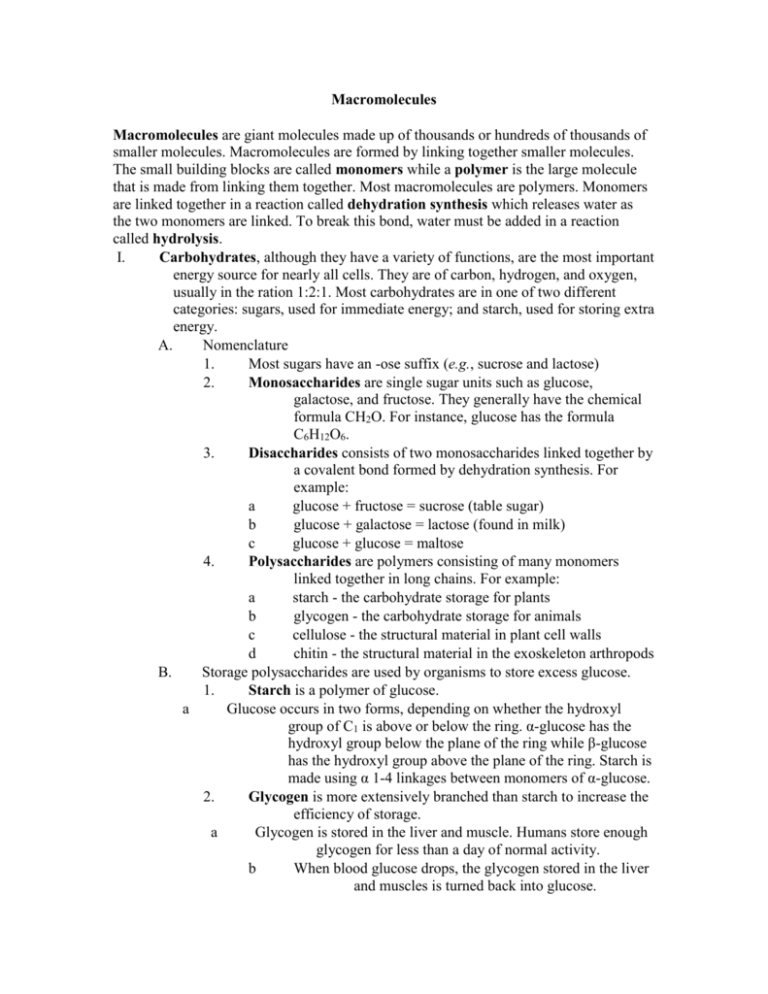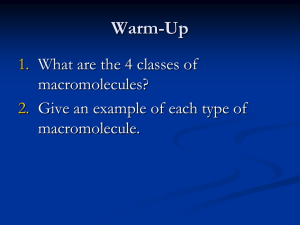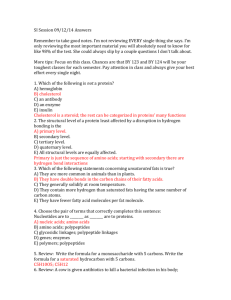Macromolecules notes
advertisement

Macromolecules Macromolecules are giant molecules made up of thousands or hundreds of thousands of smaller molecules. Macromolecules are formed by linking together smaller molecules. The small building blocks are called monomers while a polymer is the large molecule that is made from linking them together. Most macromolecules are polymers. Monomers are linked together in a reaction called dehydration synthesis which releases water as the two monomers are linked. To break this bond, water must be added in a reaction called hydrolysis. I. Carbohydrates, although they have a variety of functions, are the most important energy source for nearly all cells. They are of carbon, hydrogen, and oxygen, usually in the ration 1:2:1. Most carbohydrates are in one of two different categories: sugars, used for immediate energy; and starch, used for storing extra energy. A. Nomenclature 1. Most sugars have an -ose suffix (e.g., sucrose and lactose) 2. Monosaccharides are single sugar units such as glucose, galactose, and fructose. They generally have the chemical formula CH2O. For instance, glucose has the formula C6H12O6. 3. Disaccharides consists of two monosaccharides linked together by a covalent bond formed by dehydration synthesis. For example: a glucose + fructose = sucrose (table sugar) b glucose + galactose = lactose (found in milk) c glucose + glucose = maltose 4. Polysaccharides are polymers consisting of many monomers linked together in long chains. For example: a starch - the carbohydrate storage for plants b glycogen - the carbohydrate storage for animals c cellulose - the structural material in plant cell walls d chitin - the structural material in the exoskeleton arthropods B. Storage polysaccharides are used by organisms to store excess glucose. 1. Starch is a polymer of glucose. a Glucose occurs in two forms, depending on whether the hydroxyl group of C1 is above or below the ring. α-glucose has the hydroxyl group below the plane of the ring while β-glucose has the hydroxyl group above the plane of the ring. Starch is made using α 1-4 linkages between monomers of α-glucose. 2. Glycogen is more extensively branched than starch to increase the efficiency of storage. a Glycogen is stored in the liver and muscle. Humans store enough glycogen for less than a day of normal activity. b When blood glucose drops, the glycogen stored in the liver and muscles is turned back into glucose. C. Structural Polysaccharides 1. Cellulose is the polymer of glucose made by plants for use in the cell wall. a About 50% of all organic carbon in the biosphere is tied up in cellulose. Globally, plants produce 1011 t cellulose per year. b Cellulose is made from β-glucose and contains β 1-4 linkages. The β link has the oxygen on C1 above the plane of the ring so cellulose has a totally different shape from starch. c Enzymes which digest starch by hydrolyzing α bonds cannot recognize β links and so cannot digest cellulose. Cellulose found in foods that we eat is called fiber or roughage and is an important part of a healthy diet. 2. Chitin is found in the fungal cell wall and the exoskeleton of arthropods. II. Lipids are not polymers but are still fairly large molecules for the most part. They are made from carbon and hydrogen which makes them hydrophobic and, therefore, not soluble in water. They include fats, oils, waxes, phospholipids, and steroids. Plants are sessile and don’t need to carry energy with them so they don’t need efficient storage. Seeds are the exception. A. The main purpose of fats and oils is energy storage. They contain more than double the energy per gram as carbohydrates. 1. Many lipids are formed by combining a glycerol molecule with three fatty acids. The fats found in your blood are triglycerides made this way. 2. If each carbon atom in a fatty acid is joined to another carbon by a single bond, the lipid is said to be saturated (commonly called fats). Fat contain the maximum possible number of hydrogen atoms are “straight” chains with no double bonds are produced mostly from animals are solid at room temperature include bacon grease, lard, butter, etc. 3. If there is at least one carbon-carbon double bond in the fatty acid, it is said to be unsaturated (commonly called oils). Oils are missing one or more hydrogen atoms have double bonds which cause the chains to “kink” or “bend”are produced mostly from plants are liquid at room temperature because the kinks prevent close packing of molecules include canola oil, corn oil, peanut oil, etc. B. Phospholipids make up the membranes in all organisms. 1. They are made just as triglycerides are, except that one fatty acid is replaced with a phosphate. In other words, a phospholipid is composed of a molecule of glycerol, two fatty acids (either saturated or unsaturated), and a phosphate group (rather than a third fatty acid). The negative charge(s) of the phosphate makes the “head” of the phospholipid hydrophilic. 3. The long, hydrocarbon tails of the fatty acids are non-polar and, therefore, hydrophobic. 4. In a cell membrane, the hydrophilic heads are on the outside of the membrane (facing water) and the hydrophobic tails are on the inside of the membrane (away from water). Some steroids are lipids and are made of 4 interconnected carbon rings. 1. Cholesterol, although it gets a bad rap in health and diet circles, is the precursor for most lipid steroids and is an important component in the cell membrane D. Waxes 1. Long chain lipids joined to an alcohol or carbon ring. 2. Waxes function in waterproofing; e.g., plant cuticle, feathers. Proteins make up about 50% of the dry weight of cells and, as they are the primary structural and functional components of cells, they have many functions. A. The most important of proteins are enzymes, which help in regulating metabolism (all the reactions occurring in your cells) by acting as catalysts. Catalysts speed up the rate of a reaction by decreasing the amount of energy needed for the reaction to proceed B. Proteins are polymers made of amino acid monomers. C. Uses 1. Support - collagen, elastin, keratin 2. Storage of amino acids - ovalbumin, casein 3. Transport - hemoglobin 4. Communication a hormones - insulin b neurotransmitters - dopamine 5. Receptors - cell membrane proteins 6. Movement - actin, myosin 7. Defense - antibodies 8. Reactions - enzymes D. Each of the 20 different amino acids contains a carboxyl group, an amino group, and an R group. The R group is the variable part of the amino acid and each amino acid has a different R group. E. Amino acids are categorized into three types as determined by the R group. Each type has characteristics which cause the amino acid to behave differently in different environments. This is important for the formation of the three dimensional shape of proteins. The shape of the protein is important for its specific function. See Structure below. 1. Polar (hydrophilic) - the R group contains oxygen, nitrogen, or sulphur 2. Non-polar (hydro-phobic) - the R group contains only carbon and hydrogen 3. Charged - the R group carries a charge 2. C. III. F. G. 1. d Proteins are formed by linking together long chains (sound familiar?) of amino acids. 1. Dehydration synthesis forms a peptide bond between two adjacent amino acids. 2. Many amino acids linked together is called a polypeptide. The shape of a protein results from complex folding of the polypeptide. A polypeptide folds spontaneously into a specific shape determined by the amino acid sequence and is reinforced by interactions between R groups. There are four levels of protein structure: a Primary structure is the specific sequence of amino acids. A single change in the primary structure of the chain can cause a different protein shape, thus different function. It can even deform the protein (e.g. a single substitution of amino acid in red blood cells will result in sickle-cell anemia). Each protein has a unique primary structure. b Secondary structure is when the amino acids in the chain are twisted or folded. (1) H-bonds cause segments of the protein to be coiled or folded into one of two specific shapes: (a) α-helix (b) pleated sheet c Tertiary structure is formed by folding the chain itself and results from interactions between amino acid side chains. (1) A polar amino acid will “prefer” to be in a polar environment. For example, imagine a protein in an aqueous environment (i.e., polar) which has a series of non-polar amino acids as part of its primary structure. This section of the polypeptide will be found inside the protein away from the polar environment. These hydrophobic/hydrophilic interactions contribute to the overall shape of the polypeptide. (2) Amino acids of opposite charge can form ionic bonds to hold together segments of the polypeptide. (3) Disulfide bridges are very strong chemical bonds formed between the -SH groups of two cysteine monomers. (4) H-bonds are weak interactions formed between oxygen and hydrogen or nitrogen and hydrogen. They can be used to reinforce sections of the three dimensional shape. Quaternary structure results when 2 or more polypeptide chains associate to form the complete protein. 2. H. IV. The shape of most proteins is too complex to spontaneously form correctly without some help. Chaperone proteins hold the polypeptide in the correct configuration so that interactions can occur to for the correct shape. Disrupting the native (or natural) conformation of a protein is called denaturation. 1. If the denaturation is not too great, the protein may return to its native conformation. This is called renaturation. 2. Proteins can be denatured in several ways. a Changing the pH can disrupt ionic interactions between amino acids. b Adding salt can disrupt ionic interactions between amino acids. c Adding heat by increasing the temperature can disrupt the weak H-bonds. d Changing the environment from a polar one to non-polar one (or vice versa) interferes with the interactions between hydrophobic and hydrophilic amino acids. e Disulfide bridges can be disrupted using harsh chemicals. Nucleic acids include the polymers deoxyribonucleic acid (DNA) and ribonucleic acid (RNA). A. They are polymers formed by linking together long chains (here we go again) of nucleotide monomers. B. A nucleotide consists of: 1. A nitrogenous base, which can be either adenine, guanine, cytosine, or thymine (in the case of RNA, thymine is replaced by uracil). 2. A five-carbon sugar, which can be either ribose or deoxyribose. 3. One or more phosphate groups.









